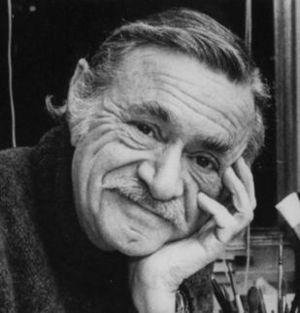Ezra Jack Keats facts for kids
Quick facts for kids
Ezra Jack Keats
|
|
|---|---|

Keats, circa 1980
|
|
| Born | Jacob Ezra Katz March 11, 1916 Brooklyn, New York |
| Died | May 6, 1983 (aged 67) |
| Occupation | Illustrator, writer |
| Nationality | American |
| Period | 1960–1983 |
| Genre | Children's picture books |
| Notable works | |
| Notable awards | Caldecott Medal 1963 |
Ezra Jack Keats (born March 11, 1916 – died May 6, 1983) was a famous American writer and artist for children's books. He won the important Caldecott Medal in 1963 for his book The Snowy Day. He wrote and illustrated this book himself. Keats also created other popular books like A Letter to Amy and Hi, Cat!. However, The Snowy Day is his most well-known work. Many people consider it one of the most important American books of the 20th century.
Keats is special because he brought different cultures into children's books. He was one of the first authors to set his stories in a big city. He also used a cool art style called collage for his pictures. This is where you make art by sticking different materials together.
Contents
Ezra Jack Keats' Amazing Books
Ezra Jack Keats' books have been translated into about 20 languages. This means kids all over the world can read them! Some of these languages include Japanese, French, Spanish, and German.
His first try at writing his own children's book was My Dog Is Lost in 1960. He wrote it with Pat Cherr. The main character is an eight-year-old boy named Juanito. He just moved to New York City from Puerto Rico and has lost his dog. As he searches, kids from different parts of the city help him. In this book, Keats used Spanish words and showed kids from different backgrounds as the main characters.
Two years later, in 1962, his famous book The Snowy Day was published. It won the Caldecott Medal in 1963. This award is for the best picture book for children. The story is about a young boy named Peter playing in the snow. Peter is African-American, but his race is not the main point of the story. Keats was inspired by a picture of a Black child from a magazine. He wrote that working on a book with a Black child as the hero "turned my life around." He felt that Black children should have always been main characters in books.
Before The Snowy Day, Keats mostly drew pictures for other people's books. But with Peter, he found his own unique way of telling stories. He used new art methods for The Snowy Day. He made collages with patterned paper, fabric, and oilcloth. He also used handmade stamps and splattered India ink with a toothbrush. Keats said he felt like "a child playing" and was "in a world with no rules." The Snowy Day became a classic children's book. It was one of 22 books Keats wrote and illustrated.
Meet Peter: A Growing Character
Peter appears in seven of Keats' books. You can watch him grow and learn in each story. These books include Whistle for Willie, Peter's Chair, A Letter to Amy, Goggles!, Hi, Cat!, and Pet Show!. Keats was good at showing the real problems and challenges kids face. In The Snowy Day, Peter is about four years old. He wants to join a snowball fight but learns he is too small when a snowball hits him. Later, he learns how to be a good older brother in Peter's Chair. He also learns to stand up for himself when he invites a girl to his birthday party in A Letter to Amy. In Goggles!, he learns to avoid trouble with older boys.
Louie's Adventures and Imagination
One special thing about Keats' stories is that his characters face real-life problems. When they solve these problems, they learn and grow. In a series of four books, starting with Louie, Keats introduces a quiet and imaginative child. Louie responds joyfully to a puppet show with a "Hello!" Louie loves to use his imagination. In The Trip, he builds a diorama in a shoebox and escapes into it. In Regards to the Man in the Moon, he builds a spaceship from old things and travels to other planets. Louie is also strong enough to search for a stepfather in Louie's Search. He also learns to stand up to kids who tease him. Keats once said that Louie was the character he felt most connected to. This is because Keats felt invisible and unloved as a child and used his creativity to escape.
Many of Keats' stories show family life and the simple, happy moments in a child's day.
Honors and Special Tributes
Ezra Jack Keats received many awards and honors for his 20 years of writing children's books:
- The Snowy Day won the Caldecott Medal. The New York Public Library also called it one of the 150 most important books of the 20th century.
- Keats was the first artist asked to design greeting cards for UNICEF.
- A skating rink in Kiyose, Japan, was named after him. This was to honor his book Skates!.
- Keats was part of the White House Forum on Child Development. He also appeared on the famous PBS show Mister Rogers' Neighborhood several times. The show Sesame Street featured his book Peter's Chair, read aloud by First Lady Barbara Bush.
- In 1980, he received the Silver Medallion from the University of Southern Mississippi. This was for being an outstanding children's book author and illustrator.
- The city of Portland, Oregon, held a parade to honor him. His readers in Tokyo, Japan also held one.
- The Imagination Playground was built in Prospect Park in Brooklyn, New York. It is based on characters from Keats' books. The main part is a bronze statue of Peter with his dog Willie. A story hour happens there every week in the summer.
- P.S. 253 in Brooklyn was renamed the Ezra Jack Keats International School.
- In 2014, the Skirball Cultural Center in Los Angeles created a big exhibit about Keats' life and work. Many news outlets like The Daily News and Time Out wrote about it. The National Endowment for the Arts also featured the exhibit.
- In 2017, the United States Postal Service created Forever stamps to honor Keats's Snowy Day. Major newspapers like the Los Angeles Times and The New York Times covered the release of these stamps.
Books Written and Illustrated by Keats
- My Dog Is Lost (1960)
- The Snowy Day (1962) — Caldecott Medal winner
- Whistle for Willie (1964)
- John Henry, An American Legend (1965)
- Jennie's Hat (1966)
- Peter's Chair (1967)
- A Letter to Amy (1968)
- Goggles! (1969) — a Caldecott runner-up
- Hi, Cat! (1970)
- Apt. 3 (1971)
- Pet Show! (1972)
- Skates! (1973)
- Pssst! Doggie- (1973)
- Dreams (1974)
- Kitten for a Day (1974)
- Louie (1975)
- The Trip (1978)
- Maggie and the Pirate (1979)
- Louie's Search (1980)
- Regards to the Man in the Moon (1981)
- Clementina's Cactus (1982)
- One Red Sun, A Counting Book (1998)
Books Adapted or Compiled by Keats
- In a Spring Garden (edited by Richard Lewis, 1965)
- The Naughty Boy: A Poem (by John Keats, 1965)
- God is in the Mountain (1966)
- The Little Drummer Boy (by Katherine Davis, Henry Ohorati and Harry Simeone, 1968)
- Night (compiled by Ezra Jack Keats, photographs by Beverly Hall, 1969)
- Over in the Meadow (by Olive A. Wadsworth, 1971)


